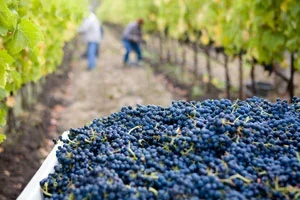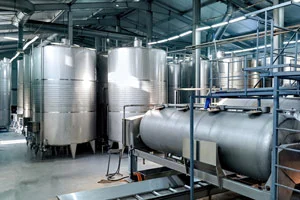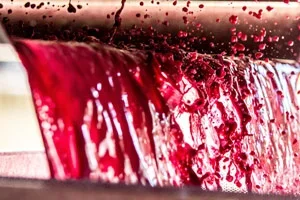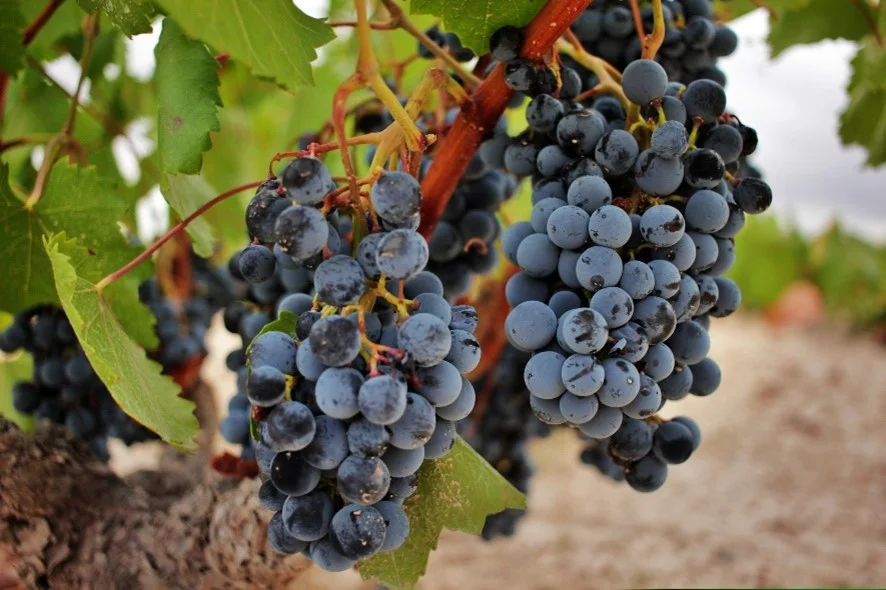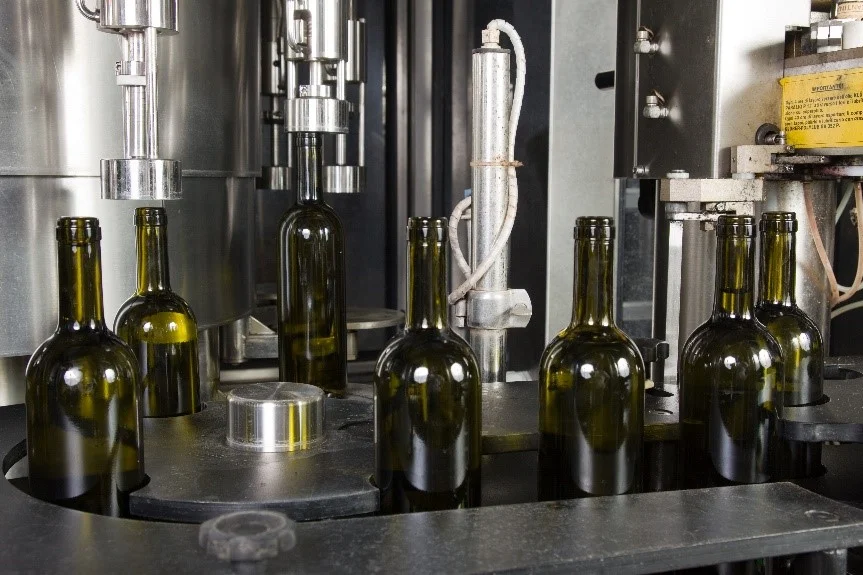Use of Torulaspora delbrueckii strain NSTD for the sensory enhancement of wines.
Agrovin S.A. Technical Department
At AGROVIN, we are aware of how climate change is affecting modern oenology, making it necessary to develop products in line with 21st century grapes. During recent years, certain changes in the grape ripening process have been observed. There is a tendency for there to be a gap between maturity in sugar content, which is earlier, and maturity of aromas and polyphenols, which is later. This makes it difficult to determine the optimal point of harvest since, if we have the appropriate probable degree, the maximum aromatic intensity has not yet been reached and the tannins are still green. This delay poses a challenge for winemakers, as the consumer prefers wines with an intense and fresh aroma, ripe tannins and lower alcohol content.
Keep in mind that the nitrogen content in the grapes depends on the soil, the crop, the fertilization and irrigation, on the load, on the variety and of course on the weather that year. Particularly important are the environmental conditions during the summer before and during harvest. In years where spring is very rainy, but summer is very dry, there is a lower concentration of nitrogen in the grapes.
The nitrogen composition of the grapes is an essential factor in developing the qualitative aptitudes of wines. It supports the intensity of the microbiological activity during alcoholic fermentation. Nitrogen needs are accentuated when the sugar concentration of the grapes is high, since it takes more generations of yeasts to consume the sugars in their entirety, so their nitrogen demand is greater. The last grams of sugars are fermented by a population at the survival limit, in a very alcoholic environment, which cannot complete its work without the necessary nitrogen resources.
Moreover, the distribution of nitrogen in the berry is heterogeneous and variable depending on the growing conditions. Most of the nitrogen compounds are located in the skin (50-55%), with the rest being distributed between pulp and the seed. During ripening, the content of nitrogenous substances increases, which then decreases during maturation. In overripe grapes harvested looking for that phenolic and aromatic maturity, which is happening later with climate change, the nitrogenous fraction decreases drastically, and the fermentations of these grapes are prone to fermentation problems, not only because of the sugar concentration, but because of the imbalance between the sugars and the nitrogenous fraction.
Sensory effect of organic nutrition.
Genesis of fermentative aromas: Amino acids are the basis of volatile compounds produced by yeasts. One third of the higher alcohols are produced during the start of alcoholic fermentation from amino acids. The esterification of these alcohols gives rise to fruity aromas that provide complexity and longevity to the wine.
Increase in varietal aromas: The amino acids (present in organic nutrition) also accentuate the aromatic complexity, increasing the varietal notes. Good nitrogenous nutrition results in the optimal performance of the enzymes (proteins) responsible for the release of aromatic precursors present in the grape: ß-glycosidases and ß-lyases increasing the wine’s varietal notes.
The varietal aromatic expression is linked to the presence of varietal thiols, beyond the so-called thiolic varieties (Sauvignon Blanc, Verdejo), which contribute to the varietal character in wines of all grape varieties, both white and red.
The 4MMP, 3MH and 3MHA varietal thiols are decisive aromas in white and red wines, because, despite their low concentration in the wine, they have a low threshold of sensory perception. In grapes, these thiols exist conjugated to amino acids, in a non-volatile form. Yeasts are able to internalize these precursors and cleave them thanks to their β-lyase activity and thus release the corresponding volatile thiols.
In this context, it has been observed that most strains of Saccharomyces cerevisiae only release a maximum of 10% of these thiol precursors under fermentation conditions. This enzymatic inefficiency has led us to investigate the release capacity of varietal thiols in different non-Saccharomyces species.
The heading of Non-Saccharomyces includes different genera and species of yeasts present in the natural process of making wine and are different from the fermentative species par excellence that is Saccharomyces cerevisiae.
In recent years, the oenological sector has turned towards the use of the resources offered by this biological diversity. Today it is known that the beneficial properties of these microorganisms should be specified at the level of each strain, not species.
For example, the Torulaspora delbrueckii NSTD strain has unusual sensory characteristics, demonstrated over several years of research. But in addition, this strain, unlike other strains of the same species, has a high prevalence in alcoholic fermentation.
Preliminary studies with T. delbrueckii NSTD showed that this strain is able to completely finish the sugars present in the must, although they needed more time than with strains of S.cerevisiae, leaving only some residual sugars at 16°C. Regarding compounds of interest at the end of fermentation, it should be noted that T. delbrueckii NSTD produces significantly lower amounts of acetic acid than S. cerevisiae, due to its ability to ferment sugars slowly.
All this points to the possibility of the joint use of NSTD in mixed cultivations from the beginning, together with the desired strain of S. cerevisiae, thus increasing the wine’s sensory notes.
Agrovin’s Viniferm NSTD provides complexity and aromatic intensity
Agrovin has been evaluating the effects of climate change on grapes for decades, analysing each and every one of the circumstances affecting each of the various wine-growing areas to offer solutions adapted to each winery, with the aim of helping them improve the quality of their wines, and obtaining in each case, the type of wine they are striving for.
That is why we have developed the Non-Saccharomyces Viniferm NSTD yeast from Agrovin, a strain of Torulaspora delbrueckii selected for its ability to improve the sensory qualities of wines. This yeast helps us increase complexity in the aromatic registers of the wine while intensifying the varietal qualities. It is notable for its strong gustatory impact, which accentuates the sensations of volume and unctuousness in the mouth, liming sensations of astringency and prolonging the aftertaste.
The NSTD strain increases varietal character due to its potent β-lyase activity (Figure 1), which is manifested in the release of thiol precursors. Among these, NSTD stands out due to the production of 4-mercapto-methyl-pentanone (4MMP), descriptors associated with notes of boxwood or broom flower.

Figure 1. Β-lyase activity of different non-Saccharomyces yeasts. Different strains of the same species exhibit different β-lyase enzyme activity. The B-lyase activity of the Torulaspora delbrueckii Viniferm NS-TD strain is notable. Belda et al. (2006) [4].
Saccharomyces strains with thiols are producers of mercapto hexanol (3MH or 3SH) or its acetate (3MHA or 3SHA), which provide the characteristic fruity aromas (grapefruit, passion fruit). Therefore, the combination of thiol Saccharomyces in mixed culture with the Torulaspora delbrueckii strain NSTD, implies an overall increase in the characteristic thiol descriptors (Figure 2).
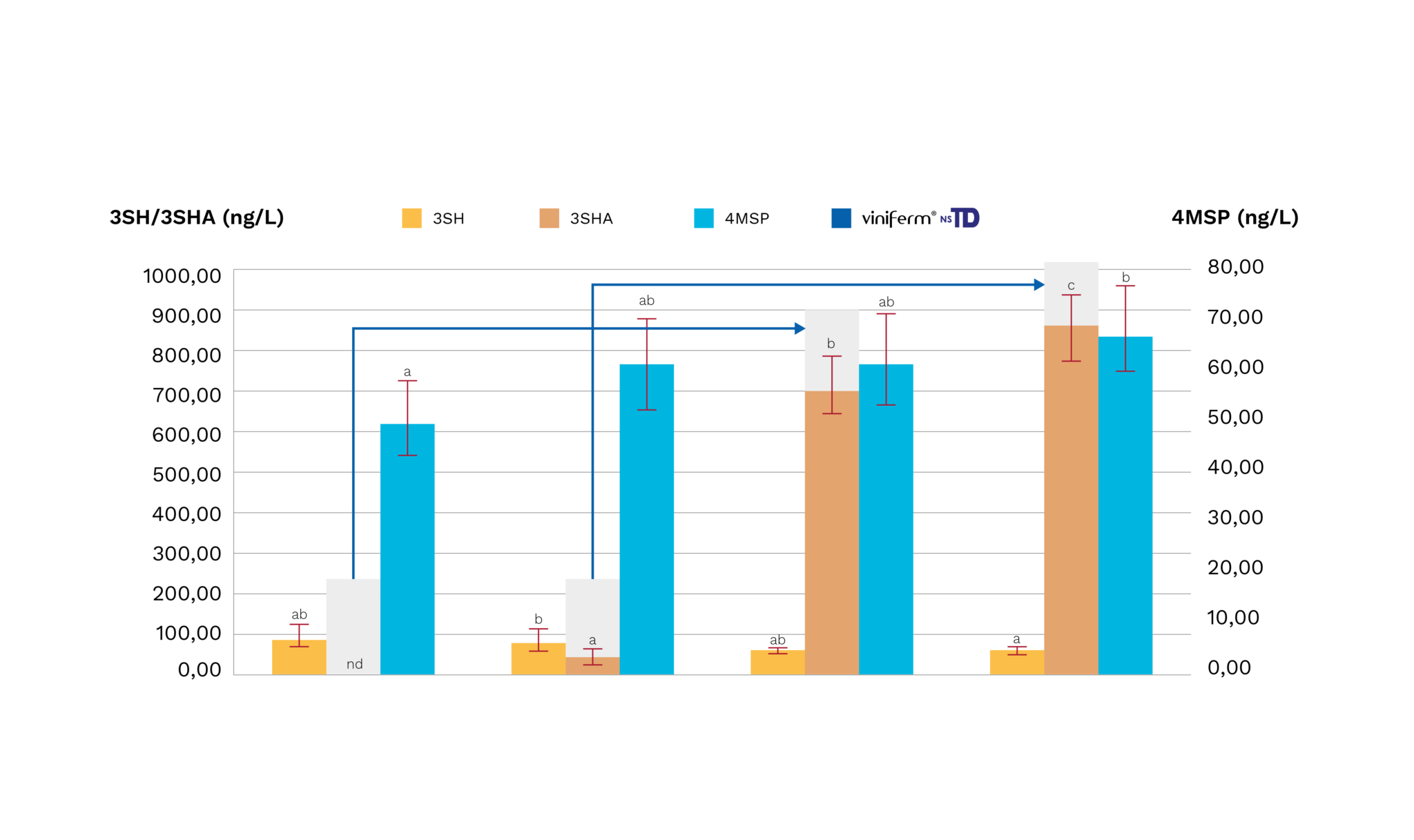
Figure 2. Concentration of thiols, 3MH and 4MMP (ng/L), after fermentation using S. cerevisiae and in combination with the NSTD strain. Belda et al. (2006) [1]. ScD: Viniferm Diana ScR: Viniferm Revelation Td…D: Mixed culture: Viniferm NS-TD + Viniferm Diana Td…R: Mixed culture: Viniferm NSTD + Viniferm Revelation
This study looks at the effect of an industrial strain of Torulaspora delbrueckii Viniferm NSTD on the production of thiols during the fermentation of white wines, and its impact on the wine’s sensory profile.
It is observed that the strains of Saccahromyces cerevisia and Viniferm Diana and especially Viniferm Revelation, both selected for their high ß-lyase activity, are capable of releasing a significant concentration of 3MH (3SH), from tropical sensory records and stone fruits that increase fruitiness.
When the activity of these strains is combined with T. delbrueckii Viniferm NSTD, there is also a strong increase in the concentration of 4MMP thiol (4MSP) with a direct impact on the wine’s aromatic profile, increasing the intensity and varietal character with positive floral and herbaceous notes (Figure 3).

Figure 3. Fermentation on Verdejo must, using S. cerevisiae or in combination with the Viniferm NSTD strain. Belda et al. (2006) ScD: Viniferm Diana; ScR: Viniferm Revelation; Td…D: Viniferm NSTD + Viniferm Diana ; Td…R: Viniferm NSTD + Viniferm Revelation The combination of the strain of Torulaspora dellbrueckii (Viniferm NSTD) and Saccharomyces of a thiol character (Viniferm Diana or Viniferm Revelation) in mixed or sequential cultures implies an overall increase in the characteristic thiol descriptors. Regarding compounds of interest at the end of fermentation, it should be noted that T. delbrueckii produces significantly lower amounts of acetic acid than S. cerevisiae, due to its ability to ferment sugars slowly. The combined activity of Viniferm NSTD with a strain of Saccharomyces cerevisiae reduces the alcoholic strength acquired. There is an increase in the wine’s polysaccharide, particularly in mannoproteins, which increases the sensation of volume in the mouth.
The results show the ability of T. delbrueckii Viniferm NSTD to increase the concentration of varietal thiols in wines, in joint fermentations with S. cerevisiae. The application of NSTD in mixed culture also implies an increase in the content of fermentative esters, intensifying the floral registers (Figure 4).

Figure 4. Concentration of fermentative esters (mg/l), after fermentation using S. cerevisiae yeasts and in combination with the NSTD strain. Belda et al. (2006) [1]. ScD: Viniferm Diana ScR: Viniferm Revelation Td…D: Mixed culture: Viniferm NS-TD + Viniferm Diana Td…R: Mixed culture: Viniferm NSTD + Viniferm Revelation. Combining the yeast strain Saccharomyces cerevisiae with the strain Viniferm NSTD results in an increase in the final content of fermentative esters.
Viniferm NSTD. Structure in the mouth and depth in the aftertaste.
There is an increase in the wine polysaccharide content, particularly mannoproteins (Figures 5 and 6), which increases the sensation of volume in the mouth. This increase in polysaccharides is also involved in the early stabilisation of the coloring matter and helps reduce astringency.
Figure 5. Increased ethanol index, reflecting the amount of tannins combined with polysaccharides. The higher the stability of coloring matter, the lower the astringency. Belda et al. (2006) [1]. ScD: Viniferm Diana ScR: Viniferm Revelation Td…D: Mixed culture: Viniferm NS-TD + Viniferm Diana Td…R: Mixed culture: Viniferm NSTD + Viniferm Revelation. As can be seen, mixed inoculation produces higher rates than fermentation with a single strain of S. cerevisiae.

Figure 6. Increase in mannoprotein content by using mixed fermentation (Sc+ NS-TD) compared to the use of Saccharomyces solitaire (Sc) Belda et al. (2006) [5]. ScD: Viniferm Diana ScDXNSTD: Mixed culture: Viniferm NS-TD + Viniferm Diana. Mixed fermentation produces 30% more mannoproteins than compared to conventional fermentation
Viniferm NSTD: adapted to the wines of climate change.
The combined activity of NSTD in mixed culture with a strain of Saccharomyces cerevisiae reduces the acquired alcoholic strength. The wines obtained have a lower volatile acidity (Table 1). In addition, given the nature of the aromas produced by this strain, both the aromatic complexity and the descriptors related to fresh fruit and varietal character are accentuated, which gives a greater sense of balance and freshness.
Table 1. Production of acetic acid and alcoholic strength acquired after fermentation with Saccharomyces cerevisiae (ScD Viniferm Diana) and after mixed fermentation of the same strain with NSTD. Belda et al. 2017 [1].
Viniferm NSTD suitable for daily work in the winery. From a fermentative point of view, the activity of Viniferm NSTD is also unusual in relation to other Non-Saccahromyces, strains since, as previously mentioned, it has a higher prevalence than usual for this group during alcoholic fermentation. This makes it possible to incorporate it together with the desired strain of Sacchromyces cerevisae from the outset, without the need to make the latter subject to the development of the former. In this way, there is a lower risk of deviations due to other microorganisms (lactic bacteria, Brettanomyces) that could take advantage of the situation to increase their population and cause problematic situations in the future. Likewise, the continued fermentation is free from additional complications resulting from the sequential application of microorganisms, such as competition for nitrogen compounds or difference in optimal fermentation temperatures.
Its fermentation activity reaches up to a probable 10 degree-conversion, so it can be used for the production of natural sweet wines or in the first fermentation of sparkling wines.
In summary, we propose working simultaneously with the Viniferm NSTD strain and the S. cerevisiae strains, in order to increase the varietal character in wines, to obtain more aromatic, more voluminous, more structured, and ultimately more complex wines.
Bibliography:
- [1] Influence of Torulaspora delbrueckii in varietal thiol (3-SH and 4-MSP )release in wine sequential fermentations. Belda, I, Ruiz, J, Beisert, Navascués, E., Marquina, D. Calderón F., Rauhut, D., Benito, S. Santos, A. International Journal of Food Microbiology 257 (2017) 183–191
- [2] Microbial Contribution to wine aroma and Its Intended Use for Wine Quality Improvement. Belda, I., Javier Ruiz , Adelaida Esteban-Fernández,, Eva Navascués, Domingo Marquina, Antonio Santos, M. Victoria Moreno-Arribas. Molecules 2017, 22, 189.
- [3] Outlining the influence of non-conventional yeasts in wine ageing over-lees Belda, I., Navascués, E., Marquina, D., Santos, A., Calderón, F., Benito, S Yeast 2016. 33 329-338.
- [4] Improvement of aromatic thiol release through the selection of yeasts with increased β-lyase activity. Belda I., Javier Ruiz , Eva Navascués , Domingo Marquina , Antonio Santos International Journal of Food Microbiology 225 (2016) 1–
- [5] Dynamic analysis of physiological properties of Torulaspora delbrueckii in wine fermentations and its incidence on wine quality. Belda,I., Navascués, E., Marquina, D., Santos A. Calderón, F., Benito, S. Applied Microbiology and Biotechnology 02/2015; 99(4):1911-1922. DOI:10.1007/s00253-014-6197-2.
ACKNOWLEDGEMENTS
This work was part of the NUTRIAROMA Project (IDI-20160102) financed by Agrovin S.A. and CDTI (Ministry of Economy, Industry and Competitiveness).
